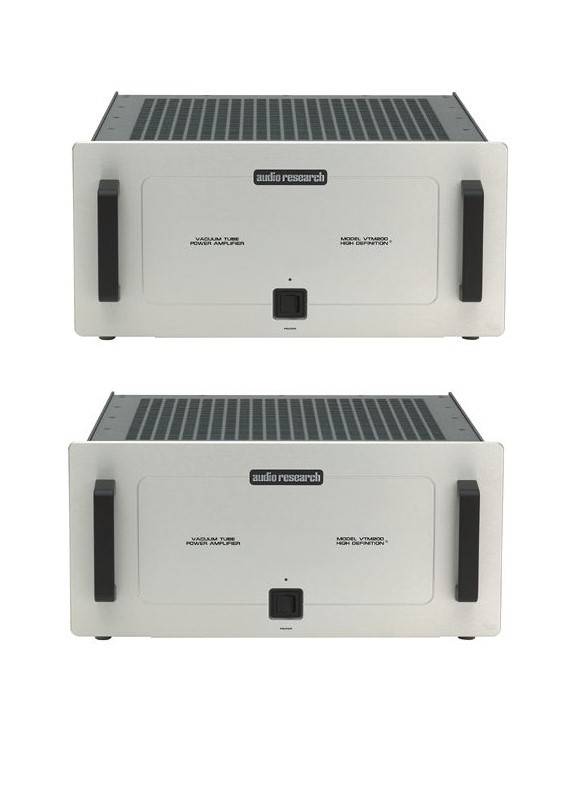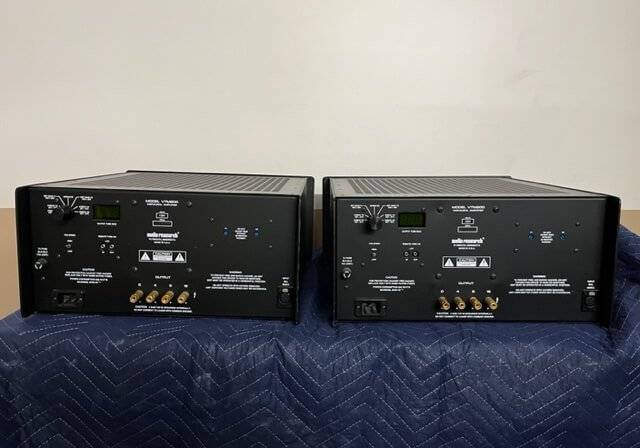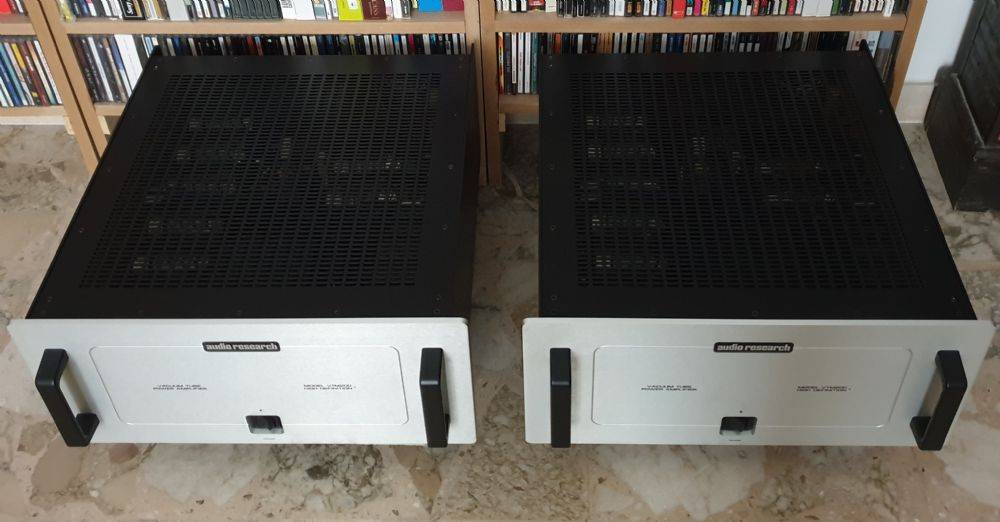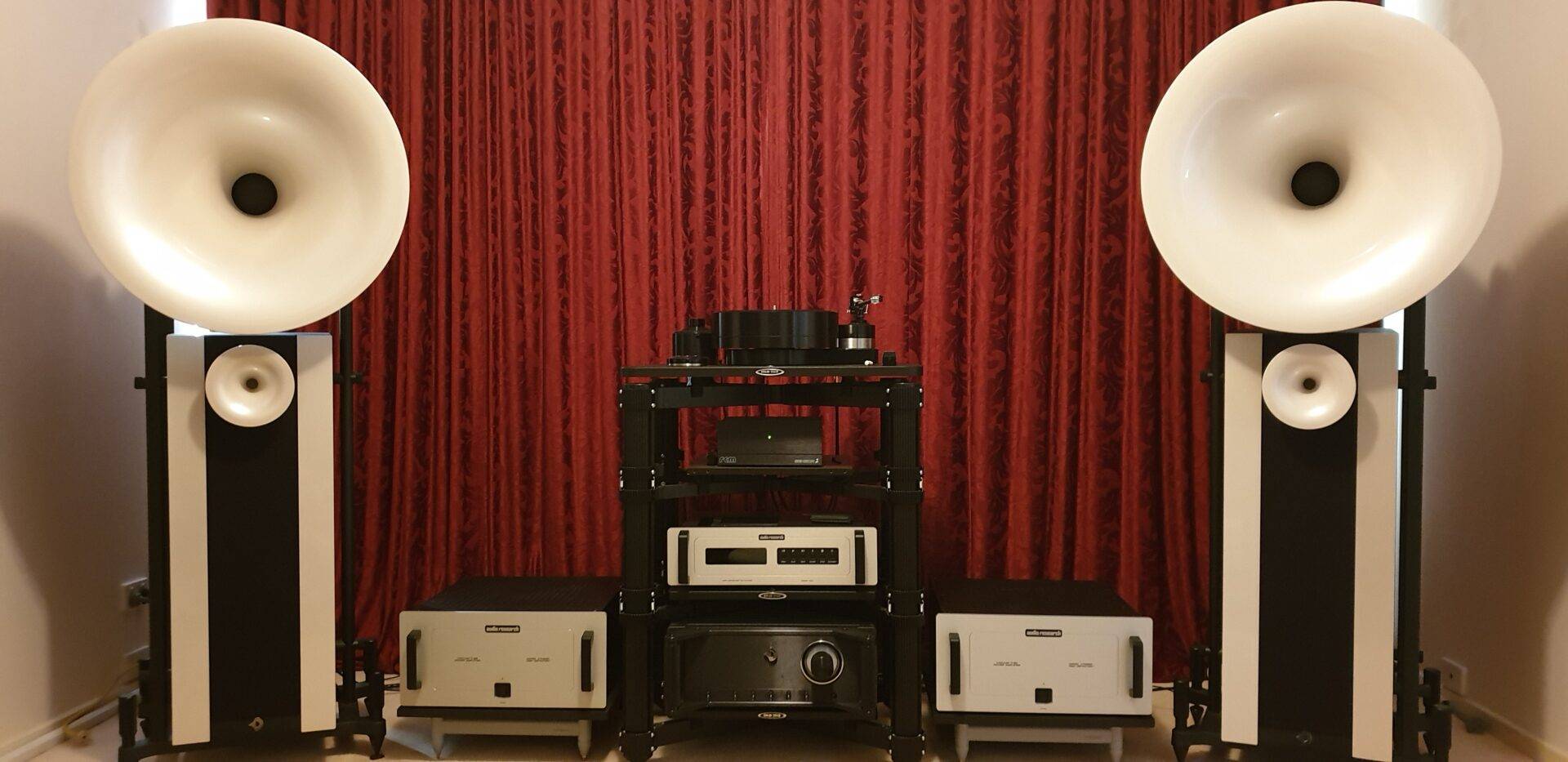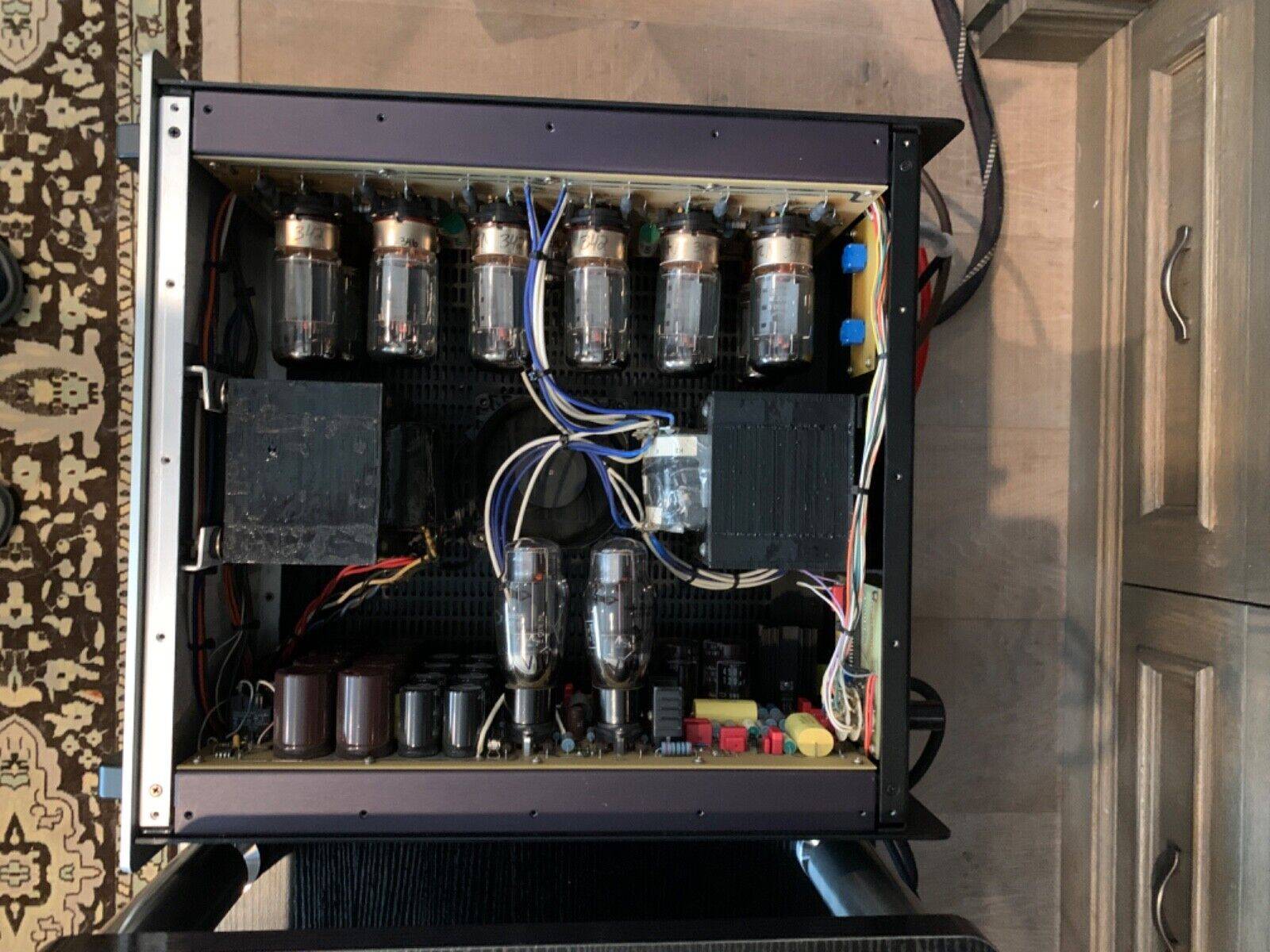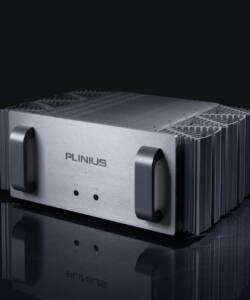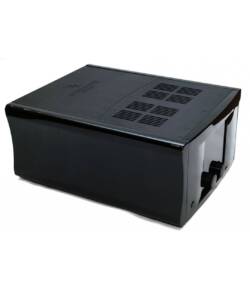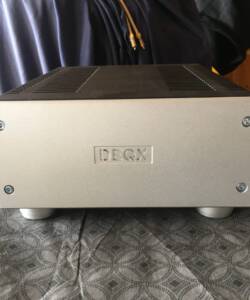Audio Research VTM200 Monoblocks
Original price was: R190,000.00.R88,000.00Current price is: R88,000.00.
Audio Research VTM200 monoblock power amplifier
The VTM200 is the first Audio Research power amplifier I’ve reviewed. It took me 13 years, and ultimately I’m glad I’d put that much mileage on my reviewing odometer before tackling what turned out to be a most difficult assignment.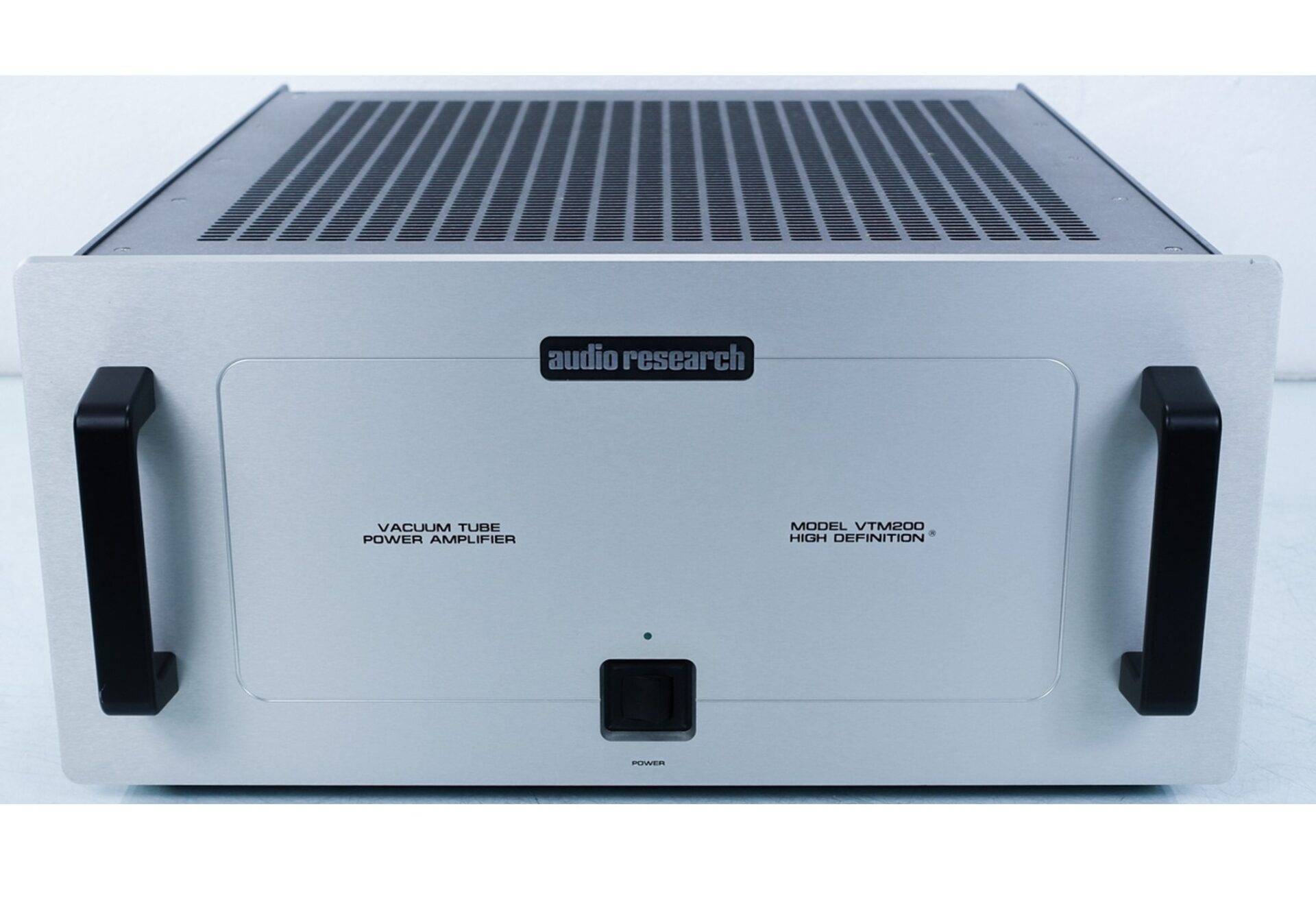
At $13,990/pair, the 200W VTM200 is the baby of ARC’s monoblock line, below the Reference 300 and $40,000 Reference 600 Mk.II. The VTM200 weighs 75 lbs—light enough for one person to carry, but still massive and imposing. I put the amps on Target stands, each of which has a Symposium Acoustics constrained-layer-damped board in place of the usual piece of wood. Then I put three of the large Walker Valid Points and discs under each amp. ARC suggests using a dedicated 15-amp line for each channel or a 20A line for a pair; I used the latter, with a separate line for the preamp and associated front-end equipment.
Introducing the New VTM200 monoblock
A week into the review, a fax arrived from Audio Research explaining the VTM200’s circuitry: low-noise, direct-coupled JFETs followed by a single 6N1P tube amplifying stage, then a pair of triode 6L6GC cathode-follower drivers, and finally three pairs of 6550 output tubes. The power supply features 438 joules of energy storage, with screen voltage for the output stage provided by two 6AS7 regulator tubes driven by another 6N1P. If all that means anything to you. To me, it means that the ARC, like my reference Musical Fidelity Nu-Vista 300, is a hybrid. But the Nu-Vista goes the opposite route, using a Nuvistor input tube and solid-state output.
Tightly packed
As with other current products from Audio Research, you have to work for your sonic supper: I had to remove 20 screws from each VTM200 so I could insert the 12 carefully marked tubes into their sockets. The tubes come cradled in styrofoam blocks crammed into spaces between circuit boards and the output transformer. I had to be very careful when pulling the blocks out lest I catch a heatsink and yank a transistor off the board. Transistor? There are a few, including direct-coupled JFETs in the input stage.
Once the tubes were in place, the covers screwed back on, the balanced XLR connectors snapped in, the speakers connected to the very nicely machined, highly torqueable custom 5-way binding posts, and the heavy-duty AC cords plugged in, I was ready to fire up the VTM200s. A two-speed fan whirred almost silently, a relay clicked, and I was almost ready to play music.
Almost? Before listening, I let the amps warm up for a half hour, then checked the bias on the output tubes. ARC makes this easy, via a rear-mounted, seven-position selector switch and LED readout: Select the tube, read the bias, and adjust it if necessary with a small screwdriver. All tubes were in the correct range and remained there for the entire review period.
Work those variables
Standard review procedure means you substitute a new component for your reference. But I had to juggle at least two additional variables so I could listen to Audio Research’s $13,990/pair VTM200 hybrid monoblocks, and that made the floor under my feet move more than once during the time I spent with them.
The VTM200’s input is balanced only, and while my Ayre K-1x preamplifier offers both balanced and single-ended outputs, I’d previously been able to use it only single-ended, which the designer of the Ayre says doesn’t sound nearly as good; besides, there’s less gain. I run single-ended Yamamura 6000 interconnect. The only balanced cable I had was so old it was growing hair, and I’d never used it. But it was all I had, and in it went until some newer cables showed up.
So when I put the VTM200s in my system, was I hearing the amplifiers? The preamp finally performing up to its potential? Old cables? Or all three? All three, of course. Nonetheless, I went in confident that, in the end, I’d be able to sort out the variables and get to the heart of what the VTM200 was all about.
First Impressions
I began with two CD-Rs I’d made using the Rockport System III Sirius turntable, and the results were mixed. On the plus side, the ARC VTM200s produced a big, firm, three-dimensional picture. I’d never heard the Sonus Faber Amati Homage loudspeakers sound so rock-solid and well-focused, particularly the “phantom center image”: the sensation of a third speaker was unusually tangible, extending from the floor to mid-room height. The presentation had weight, solidity, dimensionality, and presence. Overall, there was greater midbass weight than I was used to with my reference Musical Fidelity Nu-Vista 300 power amp, and a more intense sense of the music breaking free from the speakers. But, according to my notes, bass was “kind of rubbery” and “not in time with the rest of the music.”
I found the top end to be brighter and “faster” than I expected from a tube amp, but along with the brightness came an open, airy, and extremely detailed top without etch or sharpness. But it was bright and a trace hard, and along with it came accentuation of tape hiss, surface noise on LPs, and peaky microphones and “digititis” on poorly mastered CDs. These amps were showing no mercy to the recordings or to my ears.
I thought the upper midrange somewhat thin and underdeveloped—surprising for a tube amp—though the upper bass/lower midrange sounded “gorgeous” and rich compared to my reference. But the liquidity, transparency, and musical cohesion my system exhibited with the Hovland HP-100 preamp and the Musical Fidelity Nu-Vista 300 was nowhere to be found. My notes: “antiseptic and somewhat disjointed.” Still, I was impressed by the VTM200s’ startling dynamic authority and weight, and by the focus and clarity with which they delivered back-of-the-hall detail from familiar recordings. There was impressive dynamic and rhythmic control and superb instrumental focus and three-dimensionality, despite the rubbery bass. But the tonal picture screamed “hi-fi,” not “music.” The real sonic story wasn’t being told, and I was determined to hear it.
It was a week in which I found myself pulling out big, dynamic, closely miked recordings like the Count Basie Big Band’s Farmers’ Market Barbecue (Analogue Productions APJ 023), a wonderful-sounding LP reissue of a 1982 Pablo original. And for some reason I got into a Bernard Herrmann mood—I dusted off the Mercury Golden Import soundtrack to Vertigo (SR1 75117) and the London Phase 4 of Obsession (SPC21160), both forceful, well-focused LPs. I figured that, while waiting for some highly regarded cables to arrive, instead of forcing myself to listen to the same old references on which I always rely to make comparisons…I’d play. I ended up listening to recordings that showed off the VTM200s’ strong spatial and dynamic performance. It was an exciting stretch of listening, but somewhat off-putting.
Cables, Cables, and More Cables
This review drove it home to me big time: Cables are important, and even more important is getting good cable advice from someone who knows and understands the gear you’re using.
Jonathan Scull put me in touch with a number of cable manufacturers who were happy to send me samples, and boxes began arriving about a week after I put the amps in the system. First to arrive were the Analysis Plus Oval 9 speaker cables, intended for an upcoming review of an integrated amplifier. I need long speaker cables, and Analysis Plus sent a 20′ pair in addition to an 8′ pair.
With the long pair in the system, the overall tonal picture improved considerably, though the bass was still out of whack with the rest of the music and I still didn’t feel the system was exhibiting the musical cohesiveness and transparency that I’ve heard from far less expensive assemblages of equipment. But with the Analysis Plus cables I felt that the surprising high-frequency extension the VTM200 exhibited was more of an asset than a liability. The extension remained, but the clinical brightness was somewhat tempered. With the ARCs, I preferred the Analysis Plus Oval 9s to my long-term reference, the Yamamura 6000s.
Next to arrive was a package from Harmonic Technology. I had spoken with company president Jim Wang, who offered to send a 20′ pair of balanced Pro-Silway II interconnects, a 1.5m pair to run between my processor and preamp, and an 8′ pair of Pro-9 speaker cables. I was more interested in putting some good interconnects between the amp and preamp than in getting involved with more speaker cables, but I agreed to give them a listen.
Wang wasn’t finished. He suggested that I listen as well to the company’s Magic Woofer speaker cables: separate runs for plus and ground on each channel. I rolled my eyes as he told me that a number of his dealers felt that the Magic was the cable to use with Audio Research tube amps. “Okay, okay, I’ll give ’em a shot.”
Cable Changes Everything
With Harmonic Technology Pro-Silway II interconnect in place of the old cable, there was a significant change: The bass firmed up and rejoined the music, the midrange took on a richer, more full-bodied texture, and the top remained extended, detailed, and ultra-revealing, but not quite as bright.
Later, I inserted the Harmonic Technology Pro-9 speaker cables, and things improved even further in the same directions. Finally, I substituted Harmonic Tech’s Magic Woofer speaker cables, which are intended for full-range use and for the woofer half of a bi-amped or biwired system.
The sound had grown more musically satisfying with each cable upgrade, but with the Magic Woofer cable, the system finally began to communicate the music’s emotional center—though still not as effectively as the Hovland/Nu-Vista 300 combo had effortlessly the first time I heard it. It was as if a switch had been thrown. I know that sounds a bit dramatic, but it was unmistakable, and was reinforced when I tried another expensive set of interconnect/speaker cables, then one more “reasonably” priced. Neither of those sets was able to pull it all together as well as the Harmonic Tech cables—at least with the ARC VTM200s.
I have never heard so cable-dependent an amplifier. Perhaps the VTM200’s sensitivity has to do with its claimed extended bandwidth of 200kHz, which indicates an output transformer of extremely high quality. But no doubt: with the Amati Homages and the Ayre K-1x, the VTM200 monoblocks sounded best with the Harmonic Technology Pro-Silway II/Magic Woofer combo. That’s what I used for the review.
A Big Sound
The ARC VTM200 was musically generous, powerful, rhythmically forceful, and “fast.” Nothing warm or mellow about it, but, with the right cable, it could sound very coherent, harmonically and rhythmically, with fast, snappy, very cleanly rendered transients. It possessed tremendous drive and authority. The bottom end was very, very solid and well-controlled, with fine renderings of kick drums and acoustic bass. The lower mids to mids had the airy give of a good tube amp, while I found the upper mids and lower highs to be slightly opaque and somewhat lacking in liquidity. The top end was dead quiet, airy, open, and detailed, with a slight bit of dryness.
But don’t forget the other variable: the Ayre K-1x. If you go back and read last September’s review of the Audio Research Reference Two line stage, you’ll appreciate what would appear to be the tight, jigsaw-puzzle sonic fit between the Ref. Two’s slight warmth and its bit of softness on top and the tonal balance of these monoblocks. I felt obliged to hear these amplifiers with the Reference Two, both because I think their sound has been tailored to fit the preamp, and because I suspect it will be part of the system most Audio Research dealers will use to demo them.
Enter the Ref. Two
Fortunately, the sample of the Reference Two I had reviewed was still in New York, spending time in Jonathan Scull’s system, so I was able to get it back and substitute it for the Ayre K-1x. After two days of extended listening I found that the combination featured the expected improvements: slightly more weight and warmth on bottom, though the amps hardly were in need of that, and a bit more of the expected “give” and warmth on top.
The payoff was an even more dynamic, more exciting and detailed sonic picture. The combo created an enormous soundstage that maintained proportionality as it grew in size. Image solidity and three dimensionality became “Viewlex-like.” The combo rendered The Band’s eponymous album better than I’ve ever heard it, though as the album, recorded in Sammy Davis Jr.’s poolside cabaña, was known for its murk, the VTM200’s high-frequency character was a perfect match.
I spent one evening playing well recorded rock LPs such as Tom Petty’s Full Moon Fever, and even Fleetwood Mac’s Rumors on a plain vanilla Reprise pressing, which is the best—and I’ve heard all the contenders! I concluded that this system was an absolute stunner in terms of sheer power, dynamic expression, imaging, low-level retrieval of detail, and rhythmic tautness. The presentation was exciting, bracing, and invigorating. It was the kind of sound you can just stay up and listen to late into the night. And I did.
The next session, after a sufficient warm-up, I hit the classical shelves and I played an evening’s worth of orchestral and solo music on LP (using both original pressings and reissues) and CD. In the end, while the insertion of the Reference Two gave strings greater suppleness and warmth, I still found the presentation on the dry, analytical side. Classic’s 45rpm edition of The Royal Ballet, Gala Performances has intoxicating string sound. Though the overall presentation was nothing short of “visually” spectacular, I couldn’t get the delicacy and bloom I’d hoped for from this recording.
I had to conclude: If you’re looking for “lush,” you’ve come to the wrong place. The VTM200 was ruthless and revealing on top. It was not a softening or homogenizing agent. And, as John Atkinson noticed when he gave the amps a listen before taking them back to Brooklyn for measurements, they seemed to put surface noise in the same image space as the music, which made them somewhat less attractive when listening to vinyl that was anything less than mint.
However, with good vinyl and good-sounding CDs, and with the right associated equipment and cables, these amps put on a great show. When everything was right, tracks like Peter Case’s superbly recorded “Put Down the Gun,” from The Man with the Post-Modern Fragmented Neo-Traditionalist Blue Guitar (Geffen GHS 24238), had everything: tremendous kick-drum weight and authority, snares that snapped and cracked as they do live, and bright but sweetly shimmering cymbals. The acoustic and electric guitars had just the right mix of body and pick on string, and a sensation of “digging” on strummed strings that any guitarist would recognize as real.
On Walk With Me, a superb-sounding gospel recording by the Arc Choir (Mapleshade 04132), the spread of the group across the stage and the immediacy of the massed vocals and handclaps raised the hairs on my neck—which let me know that the system was really communicating the music. Until I’d optimized the system with the right cables, that hadn’t happened. Still, using the Ayre preamp, there was more of an unnatural physical edge to the vocal images and the handclaps than I would have preferred, though there was greater detail than I’d been used to (and more obvious tape hiss from this analog recording).
Jackson Browne’s debut album, Saturate Before Using (Asylum SD 5051), was stunning through the VTM200s. The background singers on “Dr. My Eyes” appeared as individuals in three-dimensional space as I’d not heard them before, and Jesse Davis’ electric guitar popped dynamically from the left speaker with startling clarity. I’ve always regarded this as a somewhat dull recording; the detail and crystalline clarity the ARCs brought to the top end served as a perfect complement.
Debussy’s Images for Orchestra (Charles Munch/Boston Symphony, RCA/Classic LSC-2282, LP), which positively glowed through the Hovland/Musical Fidelity combo, had a slightly drier quality. The VTM200s’ rendition was equally enticing, with a greater sensation of the hall space but a drier and less lush orchestral presentation. The amps’ ability to layer instruments front to back while suggesting the arc of their placement on the stage was as effective as I’ve heard in my room with the Amatis, and held true for all of the well-recorded classical albums I auditioned.
In short, I ended up enjoying my time with the VTM200s but wishing for a bit more…something.
Conclusion
No one in his or her right mind would spend $14,000 on a pair of monoblocks based only on a rave review, and this hasn’t been exactly a rave. Nonetheless, I hope this mixed review will not stop anyone interested from auditioning this powerful amplifier. It has a great deal to offer, especially in terms of orchestral weight, dynamic authority, and resolution of detail, and, I suspect, might have more to offer in association with other electronics and loudspeakers and cables.
I’ve heard Audio Research’s superb-sounding VT100 Mk.II and VT200 stereo amplifiers in a variety of systems using non-ARC preamps both tube and solid-state, and the VTM200 shares a similar sonic signature—except for its top end, which seemed to be somewhat out of touch with the rest of the spectrum. If you don’t need this much brute force and don’t want to spend this much, I’d suggest checking those less expensive amps out as well.
Even with cables that seemed to reconnect the top with the rest and flesh out the midrange somewhat, I had a problem with the sound of strings, which were frequently thin and rarely sensuous, even on recordings well known for superb string tone. In any case, the VTM200 demands very careful component and cable matching to sound its best, and its tonal balance—at least in my system—suggests that it was designed to be used with Audio Research’s own Reference Two line stage, or a similarly rich-sounding preamplifier.
